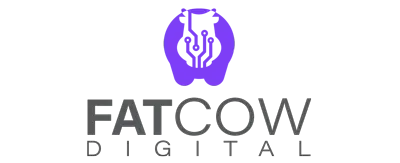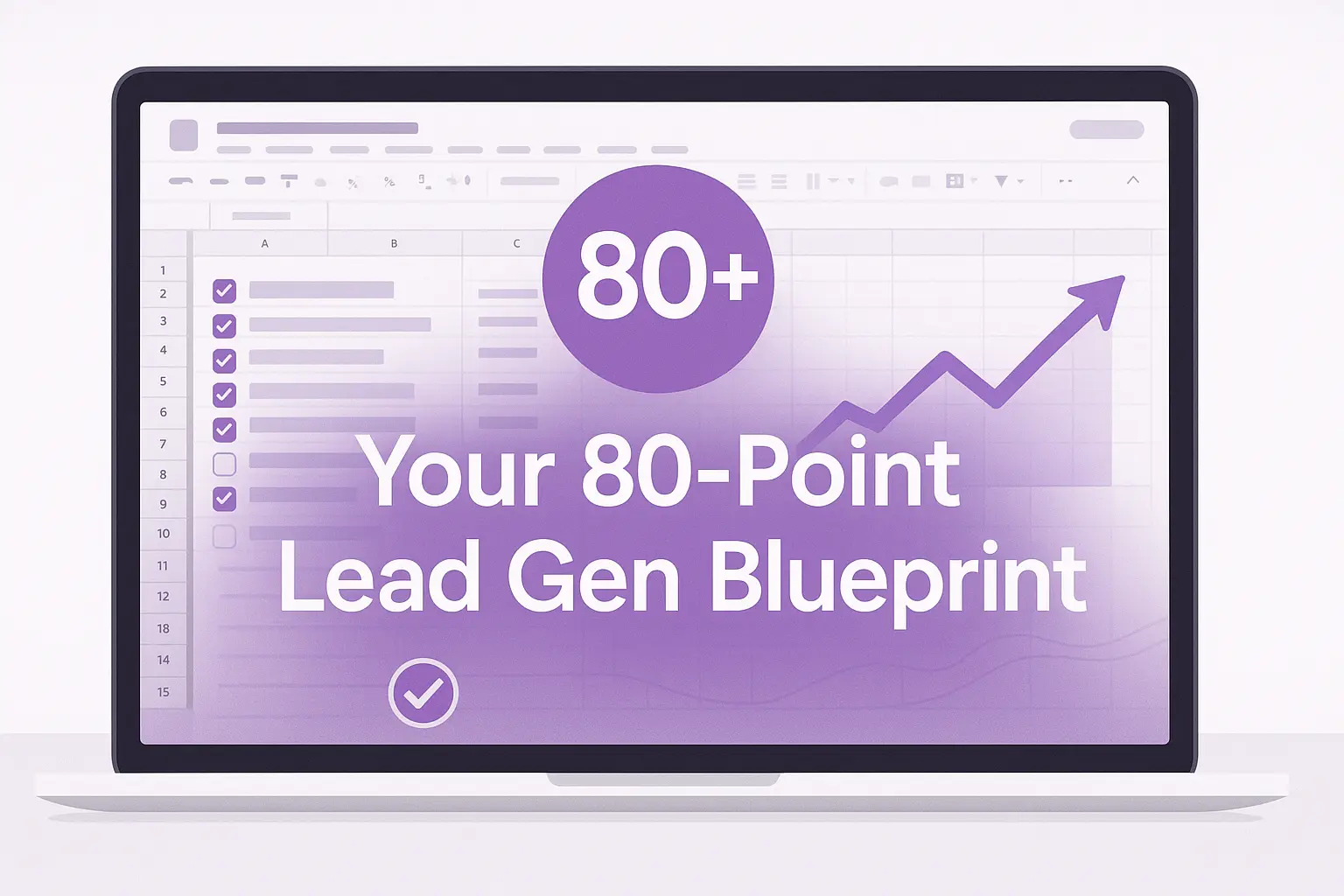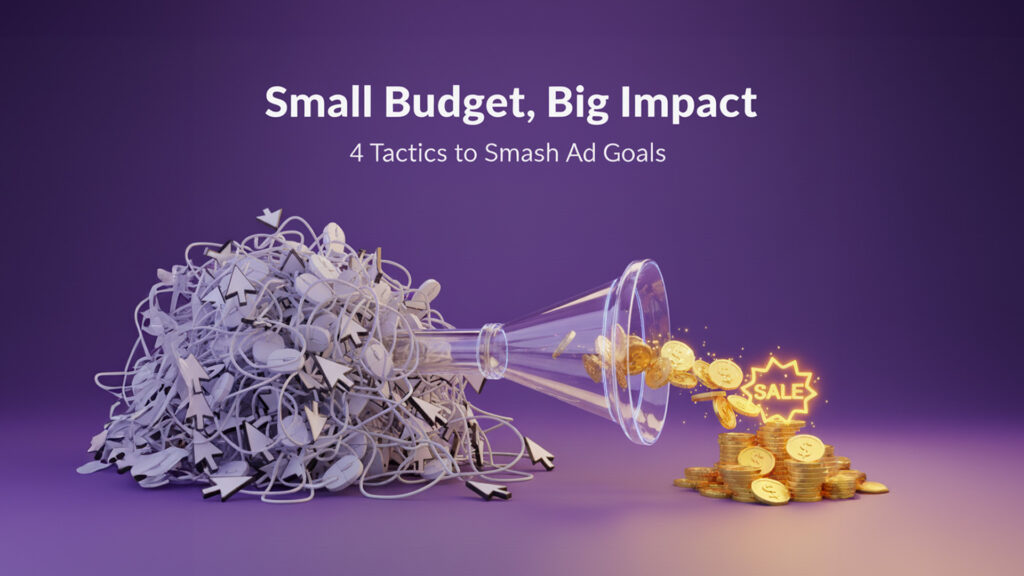Table of Contents
Are you tired of relying solely on unpredictable referrals? Do your ad campaigns bleed cash without delivering reliable, high-quality leads?
For service-based small businesses, the struggle for consistent client acquisition is real. You need a predictable system to turn marketing efforts into booked work, even on a tight budget.
This guide isn’t just another collection of tips; it’s your definitive solution. We’ve distilled years of expertise into a structured, actionable framework designed to transform your lead generation. We’ll walk you through the core strategies, culminating in our Ultimate 80-Point Lead Generation Checklist.
This isn’t just a list; it’s a comprehensive, editable Google Sheet that helps you prioritize, implement, and track the best tactics for your business. It covers everything from website optimization and content to social media, referrals, and email nurture, ensuring you get more clients now.
Ready to Stop Guessing and Start Growing?
Don’t want to read the whole article? We get it. Download the full, editable 80-Point Lead Generation Checklist Google Sheet right now and jump straight to execution!

Stop Wasting Money: Building a Lead-Optimized Foundation (Points 1–15)
Before you launch any campaign, a solid foundation is non-negotiable. This phase ensures your efforts are targeted, measurable, and compliant, setting the stage for predictable lead generation.
Know Your Numbers: Setting Goals and Budgets
Effective lead generation starts with clarity. You need to understand who your ideal client is, what you aim to achieve, and what you can afford to spend. This involves defining your Ideal Client Profile (ICP), setting SMART (Specific, Measurable, Achievable, Relevant, Time-bound) goals for lead quantity and quality, and calculating your target Cost Per Lead (CPL) to ensure profitability.
- Checklist Point 1: Define Ideal Client Profile (ICP): Create 3-5 detailed Buyer Personas (pains, budget, decision process).
- Checklist Point 2: Set SMART Goals: Establish measurable targets for Lead Quantity and Lead Quality (e.g., 50 MQLs/month).
Checklist Point 6: Calculate Target Cost Per Lead (CPL): Determine the maximum you can spend to acquire a profitable lead.
Technical Non-Negotiables for Conversion
Your digital infrastructure must be robust and conversion-focused. This includes choosing the right core channels for your business, ensuring all your data handling is compliant, and verifying that your conversion tracking is accurately capturing every lead. Without these technical elements, your marketing efforts are flying blind.
- Checklist Point 7: Choose Core Channels: Select 2-3 primary channels (e.g., SEO + LinkedIn + Paid Ads) for focused effort.
- Checklist Point 14: Document Compliance: Ensure all lead forms and data handling comply with relevant privacy regulations (GDPR, CCPA).
- Checklist Point 17: Verify Conversion Tracking: Test that all form submissions register correctly as conversions in your ad platforms/analytics.
The Power of Lead Scoring
Not all leads are created equal. Implementing lead scoring allows you to prioritize your efforts, focusing on prospects most likely to convert. This requires defining clear criteria for what constitutes a Marketing Qualified Lead (MQL) versus a Sales Qualified Lead (SQL), and assigning points based on engagement and fit.
- Checklist Point 8: Define Lead Qualification Criteria: Establish clear rules for a Marketing Qualified Lead (MQL) vs. a Sales Qualified Lead (SQL).
- Checklist Point 15: Define Lead Scoring Criteria: Assign points based on engagement (e.g., 10 points for a site visit, 50 points for downloading a guide).

Content That Converts: Attracting Your Ideal Client (Points 16–43)
Content marketing is your secret weapon for attracting and engaging leads by showcasing expertise and answering client questions. This section focuses on creating valuable content that not only ranks but also drives conversions.
SEO That Drives High-Intent Leads
To capture prospects actively searching for solutions, your content needs to be visible. This means optimizing your blog posts for conversion, creating dedicated local SEO service pages, and researching “question keywords” to directly address your ideal client’s pain points. Mobile optimization is also critical, as many service searches happen on phones.
- Checklist Point 16: Optimize Mobile Load Speed: Achieve a high score on Google PageSpeed Insights for mobile.
- Checklist Point 40: Optimize Blog Posts for “Conversion”: Embed a relevant content upgrade/lead magnet within every top-performing blog post.
- Checklist Point 43: Research “Question Keywords”: Write content specifically answering “How to…” or “What is…” questions your ICP asks.
The Best Lead Magnets for Service Businesses
Lead magnets are your primary tool for capturing contact information. They offer an immediate solution to a prospect’s problem in exchange for their details. High-value formats like free audits, value calculators, and utility checklists are particularly effective for service providers, as they demonstrate competence and filter for motivated prospects.
- Checklist Point 31: Publish a Utility Checklist/Template: Offer a simple, downloadable tool for immediate application (e.g., a process template).
- Checklist Point 33: Host an Educational Webinar/Masterclass: Use a webinar as a high-intent lead capture mechanism.
- Checklist Point 34: Offer a Free Audit/Assessment: Promote a personalized, no-obligation review of the prospect’s current situation.
Optimizing the Capture Page
Once a prospect clicks on your content or ad, the landing page must be designed for conversion. This means simplifying forms to reduce friction, strategically using exit-intent pop-ups to capture departing visitors, and ensuring clear Calls-to-Action (CTAs) are prominently placed above the fold.
- Checklist Point 20: Simplify Forms: Remove all non-essential form fields; test shorter forms vs. multi-step forms.
- Checklist Point 21: Implement Exit-Intent Pop-ups: Deploy pop-ups offering high-value magnets to departing visitors.
- Checklist Point 24: Include Clear CTAs Above the Fold: Place primary calls-to-action prominently where visitors see them immediately.
Quick Wins: Scaling Lead Flow with Paid Channels (Points 44–56)
Paid advertising and strategic social media engagement can accelerate your lead generation, offering immediate visibility and targeted reach. This section explores how to leverage these channels for maximum impact.
Frictionless Lead Ad Strategy
Social media platforms offer powerful tools for lead capture. Utilizing native lead forms on platforms like Meta (Facebook/Instagram) and LinkedIn allows prospects to submit their information quickly, often without leaving the platform, significantly reducing friction and boosting conversion rates.
- Checklist Point 44: Run Lead Form Ads (Meta/LinkedIn): Use native lead forms to capture data quickly within the social platform.
The Retargeting Imperative
Not every visitor converts on their first visit. Retargeting allows you to re-engage high-intent audiences, such as those who visited your pricing page or added items to a cart. By creating segmented audiences and uploading existing customer lists, you can deliver highly relevant ads that nudge prospects closer to conversion.
- Checklist Point 27: Utilize Retargeting Audiences: Create segmented audiences based on website pages visited (e.g., Pricing Page visitors).
- Checklist Point 48: Utilize Customer List Retargeting: Upload existing email lists to ad platforms to target known prospects with specific offers.
Social Proof in Advertising
Trust is a huge factor in service-based businesses. Leverage social proof directly in your advertising by running ads that showcase glowing testimonials, client logos, or high-value statistics from successful case studies. This builds credibility and reduces perceived risk for potential clients.
- Checklist Point 51: Post Social Proof as Ads: Run ads showing glowing testimonials or high-value statistics from client case studies.
Account-Based Marketing (ABM) for Services
For high-ticket or B2B services, Account-Based Marketing (ABM) can be incredibly effective. This strategy involves identifying a small list of high-value target accounts and running hyper-targeted ads specifically to decision-makers within those organizations, ensuring your message reaches the right people.
- Checklist Point 55: Develop an Account-Based Marketing (ABM) List: Identify 10-20 high-value target accounts and run hyper-targeted ads just to them.
From Prospect to Paying Client: Closing the Loop (Points 57–71)
Capturing a lead is just the first step. This phase focuses on nurturing those leads, building trust, and implementing strategies that convert prospects into loyal, paying clients.
The 5-Minute Follow-Up Rule
Speed is paramount in lead conversion. Studies show that responding to a lead within five minutes significantly increases your chances of qualifying them. While the checklist point here refers to gating content, the principle of immediate engagement is critical. Integrate your CRM to ensure prompt follow-up and track interactions.
- Checklist Point 37: Gate High-Value Content: Require an email for access to premium content like white papers and detailed case studies.
Automated Nurturing Sequences
Automated email sequences are essential for nurturing prospects over time. A well-crafted welcome sequence immediately after lead capture introduces your brand and builds trust. Beyond that, implement workflows that deliver staged content based on lead score or specific actions, guiding prospects from awareness to decision.
- Checklist Point 57: Create a Welcome Email Sequence: Immediately send 3-5 emails after lead capture to introduce your brand and build trust.
- Checklist Point 58: Implement Lead Nurturing Workflows: Automate email flows based on Lead Score or specific actions (e.g., not opening 3 emails).
Generating Leads from Thin Air (Referrals)
Leverage your satisfied clients and complementary businesses to generate high-quality leads. Formalizing client referral programs with clear incentives and establishing strategic partnerships with non-competing businesses can create powerful, low-cost lead streams built on trust.
- Checklist Point 60: Offer a Client Referral Program: Incentivize existing clients with discounts or rewards for successful referrals.
- Checklist Point 62: Establish Strategic Partnerships: Find 3-5 non-competing businesses that serve your ICP and establish a formal referral agreement.
Conversion Boosters on the Sales Page
Your sales page or booking process is where the final conversion happens. Reduce hesitation by offering a strong service guarantee, showcasing compelling client testimonial videos, and making it incredibly easy for hot leads to book a call immediately with an instant booking page.
- Checklist Point 29: Design an “Instant Booking” Page: Integrate a tool like Calendly so hot leads can book a call immediately.
- Checklist Point 70: Create Client Testimonial Videos: Convert written testimonials into engaging video clips for higher conversion on landing pages.
- Checklist Point 71: Offer a Service Guarantee: Use a strong guarantee (e.g., 30-day satisfaction) to eliminate prospect hesitation.
Don't Get Overwhelmed: Start Executing Now.
We’ve covered a lot of ground, from building a solid foundation and attracting clients with compelling content to accelerating growth with paid ads and nurturing leads into paying customers. The 80-Point Lead Generation Checklist provides actionable steps across all these phases, specifically tailored for service-based businesses.
Applying all 80 steps can seem daunting, but the key is to start. That’s why we’ve compiled the entire list into a beautifully organized, trackable spreadsheet. It’s designed to help you prioritize, implement, and monitor your progress, turning complex strategies into manageable tasks.
DOWNLOAD THE 80-POINT SERVICE BUSINESS LEAD GENERATION CHECKLIST (Google Sheet)
Your Blueprint for More Clients Awaits!
Stop leaving leads on the table. Download your free, editable Google Sheet and start tracking your success today!





